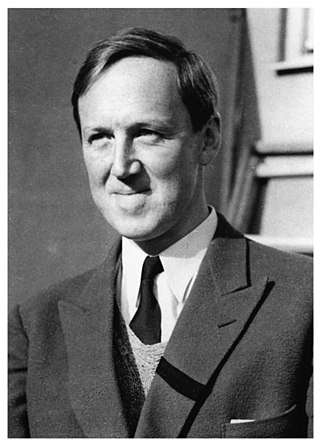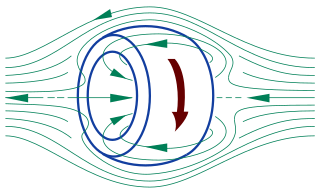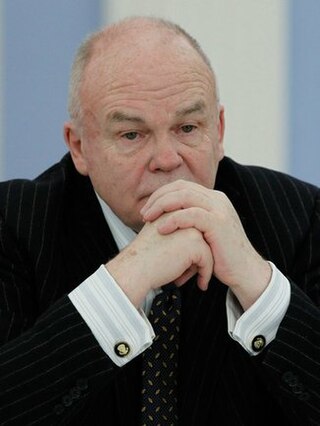Related Research Articles

A tokamak is a device which uses a powerful magnetic field to confine plasma in the shape of a torus. The tokamak is one of several types of magnetic confinement devices being developed to produce controlled thermonuclear fusion power. As of 2016, it was the leading candidate for a practical fusion reactor. The word "tokamak" is derived from a Russian acronym meaning "toroidal chamber with magnetic coils".

The stability of a plasma is an important consideration in the study of plasma physics. When a system containing a plasma is at equilibrium, it is possible for certain parts of the plasma to be disturbed by small perturbative forces acting on it. The stability of the system determines if the perturbations will grow, oscillate, or be damped out.

Magnetohydrodynamics is a model of electrically conducting fluids that treats all interpenetrating particle species together as a single continuous medium. It is primarily concerned with the low-frequency, large-scale, magnetic behavior in plasmas and liquid metals and has applications in numerous fields including geophysics, astrophysics, and engineering.

Hannes Olof Gösta Alfvén was a Swedish electrical engineer, plasma physicist and winner of the 1970 Nobel Prize in Physics for his work on magnetohydrodynamics (MHD). He described the class of MHD waves now known as Alfvén waves. He was originally trained as an electrical power engineer and later moved to research and teaching in the fields of plasma physics and electrical engineering. Alfvén made many contributions to plasma physics, including theories describing the behavior of aurorae, the Van Allen radiation belts, the effect of magnetic storms on the Earth's magnetic field, the terrestrial magnetosphere, and the dynamics of plasmas in the Milky Way galaxy.

A magnetohydrodynamic drive or MHD accelerator is a method for propelling vehicles using only electric and magnetic fields with no moving parts, accelerating an electrically conductive propellant with magnetohydrodynamics. The fluid is directed to the rear and as a reaction, the vehicle accelerates forward.
A magnetohydrodynamic generator is a magnetohydrodynamic converter that transforms thermal energy and kinetic energy directly into electricity. An MHD generator, like a conventional generator, relies on moving a conductor through a magnetic field to generate electric current. The MHD generator uses hot conductive ionized gas as the moving conductor. The mechanical dynamo, in contrast, uses the motion of mechanical devices to accomplish this.

A field-reversed configuration (FRC) is a type of plasma device studied as a means of producing nuclear fusion. It confines a plasma on closed magnetic field lines without a central penetration. In an FRC, the plasma has the form of a self-stable torus, similar to a smoke ring.

Alcator C-Mod was a tokamak that operated between 1991 and 2016 at the Massachusetts Institute of Technology (MIT) Plasma Science and Fusion Center (PSFC). Notable for its high toroidal magnetic field, Alcator C-Mod holds the world record for volume averaged plasma pressure in a magnetically confined fusion device. Until its shutdown in 2016, it was one of the major fusion research facilities in the United States.

The Plasma Science and Fusion Center (PSFC) at the Massachusetts Institute of Technology (MIT) is a university research center for the study of plasmas, fusion science and technology.
The Versatile Toroidal Facility (VTF) is a research group within the Physics Research Division of the MIT Plasma Science and Fusion Center at the Massachusetts Institute of Technology. The VTF is a laboratory focused on studying the phenomenon of magnetic reconnection. For this purpose the group has a small tokamak designed to observe rarefied plasmas with probes. These probes measure electric and magnetic field behavior as well as various plasma characteristics in order to better understand the poorly understood processes involved in magnetic reconnection.

Evgeny Pavlovich Velikhov is a physicist and scientific leader in the Russian Federation. His scientific interests include plasma physics, lasers, controlled nuclear fusion, power engineering, and magnetohydrodynamics. He is the author of over 1500 scientific publications and a number of inventions and discoveries.
The ballooning instability is a type of internal pressure-driven plasma instability usually seen in tokamak fusion power reactors or in space plasmas. It is important in fusion research as it determines a set of criteria for the maximum achievable plasma beta. The name refers to the shape and action of the instability, which acts like the elongations formed in a long balloon when it is squeezed. In literature, the structure of these elongations are commonly referred to as 'fingers'.

Harold Grad was an American applied mathematician. His work specialized in the application of statistical mechanics to plasma physics and magnetohydrodynamics.
Richard J. Temkin is a plasma physicist and researcher on plasma-heating gyrotrons and other electromagnetic devices involving high-powered microwaves or terahertz radiation.
Hartmut Zohm is a German plasma physicist who is known for his work on the ASDEX Upgrade machine. He received the 2014 John Dawson Award and the 2016 Hannes Alfvén Prize for successfully demonstrating that neoclassical tearing modes in tokamaks can be stabilized by electron cyclotron resonance heating, which is an important design consideration for pushing the performance limit of the ITER.
Ksenia Aleksandrovna Razumova is a Russian physicist. She graduated from the Physical Faculty of Moscow University in 1955 and took a position at the then called Kurchatov Institute of Atomic Energy in Moscow, then USSR. She defended her Ph.D. in 1966, was Candidate in Physical and Mathematical sciences in 1967, and became Doctor of Sciences in 1984. She is laboratory head at the Institute of Nuclear Fusion, Russian Research Centre Kurchatov Institute. Since the beginning she is actively involved plasma physics in research on the tokamak line of Magnetic confinement fusion.

SPARC is a tokamak under development by Commonwealth Fusion Systems (CFS) in collaboration with the Massachusetts Institute of Technology (MIT) Plasma Science and Fusion Center (PSFC). Funding has come from Eni, Breakthrough Energy Ventures, Khosla Ventures, Temasek, Equinor, Devonshire Investors, and others.
Harold Weitzner is an American applied mathematician and physicist whose primary research is plasma physics. He is Professor Emeritus of Mathematics at the Courant Institute of Mathematical Sciences and has served as Director of the Magneto-Fluid Dynamics Division at Courant since 1981, succeeding Harold Grad. He has published over 120 research articles on the topics of plasma physics, magnetohydrodynamics, fluid mechanics, fractional equations and kinetics, and chaos.

Ambrogio Fasoli is a researcher and professor working in the field of fusion and plasma physics. A Fellow of the American Physical Society, he is Director of the Swiss Plasma Center, located at EPFL, the Swiss Federal Institute of Technology in Lausanne, Switzerland. Since 1 January 2019, he chairs the European consortium EUROfusion, the umbrella organisation for the development of nuclear fusion power in Europe.
Alan Herbert Glasser is an American physicist.
References
- ↑ "MIT History: Department of Nuclear Science and Engineering". MIT Libraries. MIT . Retrieved 2017-08-16.
- ↑ Freidberg, Jeffrey P. (1987). Ideal magnetohydrodynamics. Plenum Publishing Corporation. ISBN 9780306425127 – via Google Books.
- ↑ Romm, Joe (2012-10-10). "NY Times: Funding For Fusion 'Better Spent On Renewable Sources Of Energy That Are Likely To Be Cheaper And Quicker'". nytexaminer.com.
- 1 2 "MIT NSE: Faculty: Jeffrey P. Freidberg". mit.edu.
- ↑ "New York University > Courant Institute > Department of Mathematics > Magneto-Fluid Dynamics Division: People". nyu.edu. Retrieved 2017-08-16.
- 1 2 Porkolab, Miklos (2011-08-03). "FPN11-41: Martin Greenwald Named Associate Director, PSFC, MIT". Fusion Program Notes. Fusion Power Associates. Retrieved 2017-08-16.
- ↑ Freidberg, Jeffrey P. (2014-06-26). Ideal MHD. Cambridge University Press. ISBN 9781107006256 – via Google Books.
- ↑ Freidberg, Jeffrey P. (2007-02-08). Plasma Physics and Fusion Energy. Cambridge University Press. doi:10.1017/CBO9780511755705. ISBN 9780521851077.; Freidberg, Jeffrey P. (2008-07-10). Plasma Physics and Fusion Energy. Cambridge University Press. ISBN 9781139462150 – via Google Books.